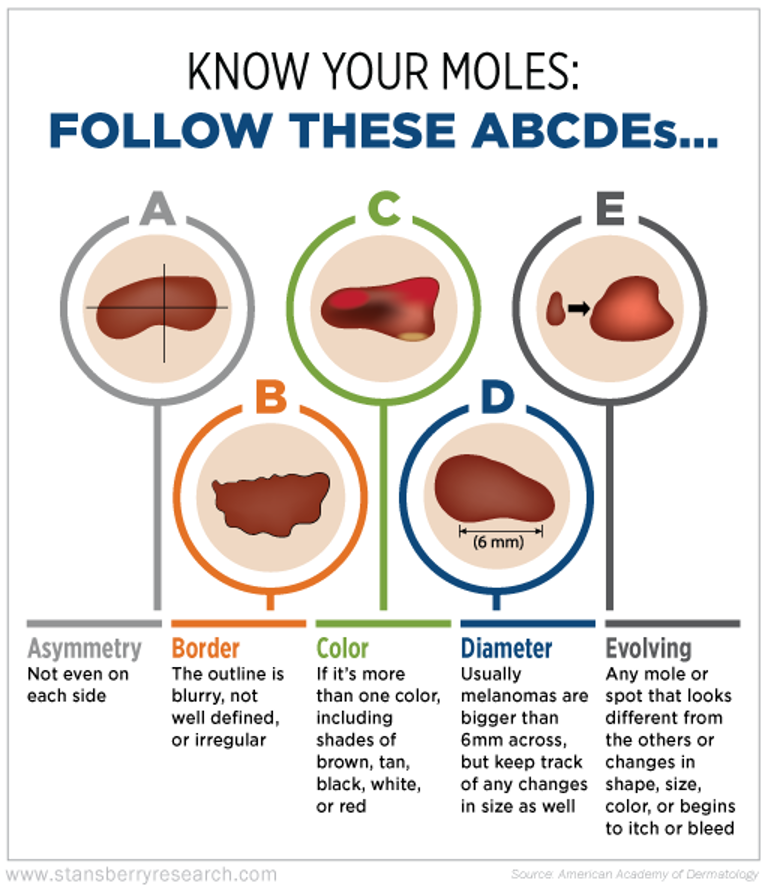Years ago, I probably saved a good friend's life...
One day, I noticed something on the skin of Stansberry Research's founder Porter Stansberry. I insisted he see a skin doctor... who found it was melanoma.
This type of skin cancer was at the lowest level of both depth and size that you can get and actually have a good prognosis.
Skin cancer looks like a slightly strange mole. In fact, some benign moles can turn cancerous. There are ways to tell potentially cancerous moles from benign ones... Cancerous moles are asymmetrical, have irregular borders or uneven color, and change in size or appearance.
But the only way to definitively identify whether a mole is cancerous is through monitoring and screening.
The three main types of skin cancer are basal-cell skin cancer (the most common), melanoma, and squamous-cell skin cancer.
Basal-cell skin cancer appears on the face and other areas that have regular sun exposure. Melanoma occurs anywhere on the skin's surface. It can even occur on the eye and in the intestines.
Both basal-cell skin cancer and melanoma are more common among white people than folks from other races. Squamous-cell skin cancer is the most common type of skin cancer in other races and it usually appears on legs and feet. For white people, squamous-cell skin cancer appears on the head, face, ears, and neck.
Melanoma is the most dangerous of the three... Rather than staying on the surface, it grows deep into your skin, worsening its spread to other parts of the body.
One in every 5 people in the U.S. will develop some form of skin cancer by the age of 70. Skin cancer is the most commonly diagnosed cancer each year. The good news is that most skin cancers aren't that dangerous, especially when caught early. That's why folks should have this checked at least once a year.
Outside of your regular checkups, use the "ABCDE" warning signs to determine whether a doctor should look at an abnormal skin mark.
- A = Asymmetrical
- B = Border is uneven
- C = Color changes, or it's more than one color
- D = Diameter is a quarter-inch or larger, about the size of a pencil eraser. Also, these are darker than other moles.
- E = Evolving by changing shape, size, or color
These potentially dangerous marks could appear anywhere on the skin. They don't mean you have cancer, but if you develop any of these signs, it's time for a professional to take a look.
Your dermatologist should create a map of the moles and marks on your body and monitor it every year, especially if you're someone with a lot of skin spots and a family history of skin cancer. If your dermatologist detects something that looks abnormal, a biopsy can determine whether it's malignant (meaning cancerous) or benign (harmless).
In addition to the exam, you should also lower your risks of developing skin cancer by protecting yourself from the sun. Your skin is most vulnerable from about 11 a.m. to 2 p.m., when the sun is hottest and highest in the sky.
Do what I do and wear a long-sleeved shirt, hat, and sunglasses if you're going to be outside in the midday sun. If you're planning to use sunscreen, find one that's nontoxic. A lot of sunscreens contain ingredients that can cause cancer.
I try and avoid lotions stronger than SPF 4, because I don't want high concentrations of the dangerous chemicals in sunscreens. But if you know you're someone who burns easily, slather some non-nano zinc oxide sunscreen, like from the brand Badger, onto any uncovered areas an hour or so before high noon.
I've studied the research, looked at the facts, and found that skin-cancer screening is one of the most important exams to maintain your health.
What We're Reading...
- The most unexpected places you can get skin cancer.
- Something different: Advanced Micro Devices is going after Nvidia.
Here's to our health, wealth, and a great retirement,
Dr. David Eifrig and the Health & Wealth Bulletin Research Team
June 4, 2024

